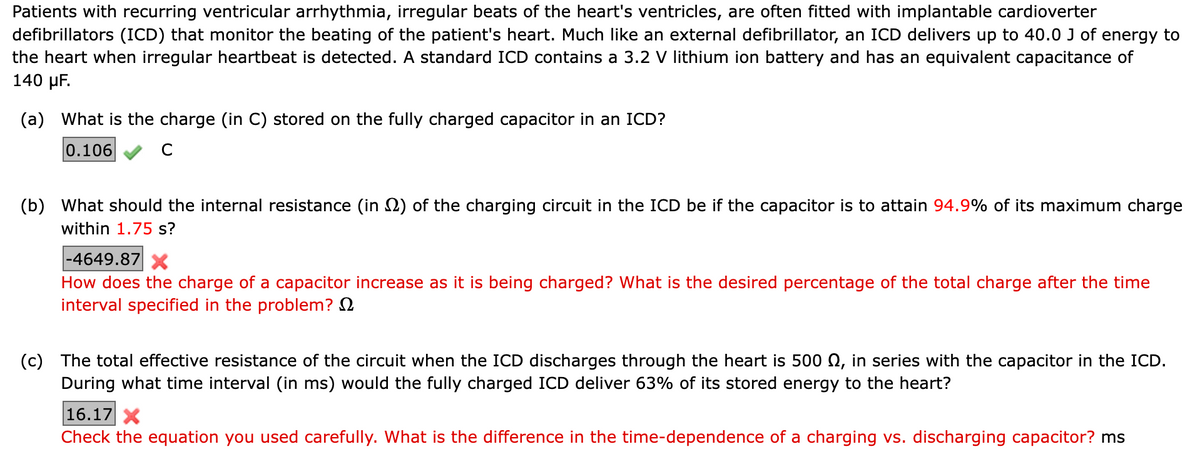Patients with recurring ventricular arrhythmia, irregular beats of the heart's ventricles, are often fitted with implantable cardioverter defibrillators (ICD) that monitor the beating of the patient's heart. Much like an external defibrillator, an ICD delivers up to 40.0 J of energy to the heart when irregular heartbeat is detected. A standard ICD contains a 3.2 V lithium ion battery and has an equivalent capacitance of 140 μF. (a) What is the charge (in C) stored on the fully charged capacitor in an ICD? 0.106 C (b) What should the internal resistance (in 2) of the charging circuit in the ICD be if the capacitor is to attain 94.9% of its maximum charge within 1.75 s? -4649.87 X How does the charge of a capacitor increase as it is being charged? What is the desired percentage of the total charge after the time interval specified in the problem? (c) The total effective resistance of the circuit when the ICD discharges through the heart is 500 , in series with the capacitor in the ICD. During what time interval (in ms) would the fully charged ICD deliver 63% of its stored energy to the heart? 16.17 X Check the equation you used carefully. What is the difference in the time-dependence of a charging vs. discharging capacitor? ms
Patients with recurring ventricular arrhythmia, irregular beats of the heart's ventricles, are often fitted with implantable cardioverter defibrillators (ICD) that monitor the beating of the patient's heart. Much like an external defibrillator, an ICD delivers up to 40.0 J of energy to the heart when irregular heartbeat is detected. A standard ICD contains a 3.2 V lithium ion battery and has an equivalent capacitance of 140 μF. (a) What is the charge (in C) stored on the fully charged capacitor in an ICD? 0.106 C (b) What should the internal resistance (in 2) of the charging circuit in the ICD be if the capacitor is to attain 94.9% of its maximum charge within 1.75 s? -4649.87 X How does the charge of a capacitor increase as it is being charged? What is the desired percentage of the total charge after the time interval specified in the problem? (c) The total effective resistance of the circuit when the ICD discharges through the heart is 500 , in series with the capacitor in the ICD. During what time interval (in ms) would the fully charged ICD deliver 63% of its stored energy to the heart? 16.17 X Check the equation you used carefully. What is the difference in the time-dependence of a charging vs. discharging capacitor? ms
College Physics
10th Edition
ISBN:9781285737027
Author:Raymond A. Serway, Chris Vuille
Publisher:Raymond A. Serway, Chris Vuille
Chapter18: Direct-Current Circuits
Section: Chapter Questions
Problem 37P: Figure P18.37 shows a simplified model of a cardiac defibrillator, a device used to patients in...
Related questions
Question

Transcribed Image Text:Patients with recurring ventricular arrhythmia, irregular beats of the heart's ventricles, are often fitted with implantable cardioverter
defibrillators (ICD) that monitor the beating of the patient's heart. Much like an external defibrillator, an ICD delivers up to 40.0 J of energy to
the heart when irregular heartbeat is detected. A standard ICD contains a 3.2 V lithium ion battery and has an equivalent capacitance of
140 μF.
(a) What is the charge (in C) stored on the fully charged capacitor in an ICD?
0.106
C
(b) What should the internal resistance (in ) of the charging circuit in the ICD be if the capacitor is to attain 94.9% of its maximum charge
within 1.75 s?
-4649.87 X
How does the charge of a capacitor increase as it is being charged? What is the desired percentage of the total charge after the time
interval specified in the problem?
(c) The total effective resistance of the circuit when the ICD discharges through the heart is 500 , in series with the capacitor in the ICD.
During what time interval (in ms) would the fully charged ICD deliver 63% of its stored energy to the heart?
16.17 X
Check the equation you used carefully. What is the difference in the time-dependence of a charging vs. discharging capacitor? ms
Expert Solution
This question has been solved!
Explore an expertly crafted, step-by-step solution for a thorough understanding of key concepts.
Step by step
Solved in 2 steps with 2 images

Knowledge Booster
Learn more about
Need a deep-dive on the concept behind this application? Look no further. Learn more about this topic, physics and related others by exploring similar questions and additional content below.Recommended textbooks for you

College Physics
Physics
ISBN:
9781285737027
Author:
Raymond A. Serway, Chris Vuille
Publisher:
Cengage Learning

College Physics
Physics
ISBN:
9781305952300
Author:
Raymond A. Serway, Chris Vuille
Publisher:
Cengage Learning

Principles of Physics: A Calculus-Based Text
Physics
ISBN:
9781133104261
Author:
Raymond A. Serway, John W. Jewett
Publisher:
Cengage Learning

College Physics
Physics
ISBN:
9781285737027
Author:
Raymond A. Serway, Chris Vuille
Publisher:
Cengage Learning

College Physics
Physics
ISBN:
9781305952300
Author:
Raymond A. Serway, Chris Vuille
Publisher:
Cengage Learning

Principles of Physics: A Calculus-Based Text
Physics
ISBN:
9781133104261
Author:
Raymond A. Serway, John W. Jewett
Publisher:
Cengage Learning

Physics for Scientists and Engineers: Foundations…
Physics
ISBN:
9781133939146
Author:
Katz, Debora M.
Publisher:
Cengage Learning

Physics for Scientists and Engineers, Technology …
Physics
ISBN:
9781305116399
Author:
Raymond A. Serway, John W. Jewett
Publisher:
Cengage Learning
